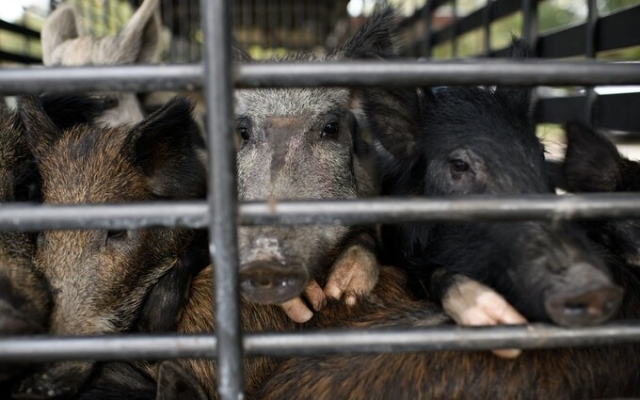 Northern US states are bracing for an influx of wild “super pigs” from Canada, where their numbers have gotten out of control. Photo: Mark Felix/Bloomberg
Northern US states are bracing for an influx of wild “super pigs” from Canada, where their numbers have gotten out of control. Photo: Mark Felix/Bloomberg
The United States faces the threat of an invasion of wild “super pigs” from Canada, experts warn.
Saskatchewan professor Ryan Brooke called them “the most aggressive animals on the planet.” , the pig population is growing rapidly.
According to a 2019 study, the number of pigs (a cross between a farm pig and a wild boar) is increasing by nine percent per year.
The pig invasion comes at a time when the US is already struggling to contain feral pigs in other parts of the country, where their numbers are estimated at six million in 35 states.
“Wild pigs are an environmental train wreck. They are prolific breeders, making them an extremely successful invasive species,” says researcher Ruth Ashim.
“Wild pigs can cause soil erosion, degrade water quality, destroy crops, and prey on small mammals, amphibians and birds «.
The problem started when wild boars were imported from Europe.
The problem started when wild boars were imported. from Europe in the late 1980s and early 1990s.
Some were imported to diversify livestock, others as game for hunters.
But the demand for wild boar food never increased, and in the early years of the 21st century, farmers cut down fences and let the pigs roam as they pleased.
By 2017, they had expanded across Canada, most of it in Saskatchewan.< /p>Sows can have a dozen piglets each a year
Prolific Breeders — Sows can have a dozen piglets each a year — the superpigs spreading south will eat almost anything, and they trample farmland, leaving a trail of destruction in their wake.
They are estimated to cause $2.5 billion in crop damage per year in the United States. They are also aggressive: in 2019, wild pigs killed a woman in Texas.
Northern US states are already taking action. Earlier this month, Minnesota announced what it called a «proactive review» of ways to address the problem.
Montana has set up a hotline urging the public to report sightings of animals that may carry more than 30 diseases and parasites .
Early detection and rapid response are the key to success. Eradication of small populations and minimizing the impact of these invasive species is important to protect the region's economy and natural resources,” the public was told.























































Свежие комментарии